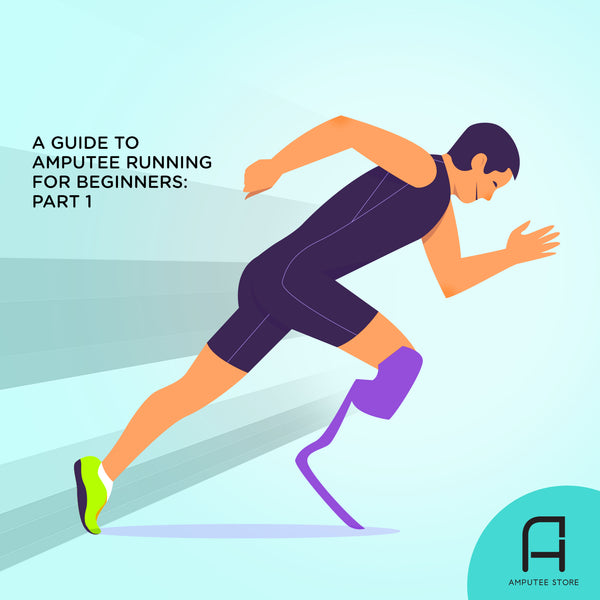A Beginners' Guide to Amputee Running: Part 1
Our "Amputee Running Series" aims to provide you with a practical guide to help you begin running with your prosthesis. This first installment will touch on the basics—what you need to work on to prepare your body to run. Upcoming articles will offer more advanced tips and information.

How to start prosthetic running today
Our bodies are designed for movement. Regular physical activity offers a whole host of benefits—lower blood pressure, body fat control, and improved mental functioning, among others. Because we lead an increasingly sedentary life, we miss out on these health benefits, and this is when health problems may begin.
One of the easiest and most accessible physical activity to everyone is running. In fact, several experts believe that the human body has evolved to be an endurance runner.
Running is known to activate the release of feel-good hormones while simultaneously offering significant health benefits. So, if you’d like to start "amputee running", let's begin this series by preparing our bodies.
Prosthetic running requirements
Whether you’re a single-leg amputee or a bilateral amputee, the most important gear you’ll wear when running is your prosthesis. This list explores the different prosthetic-related requirements that you need to prepare.
Skin health
To withstand the constant impact that comes with running with a prosthetic leg, the skin around your residual limb needs to be strong, resilient, and healthy. Unhealthy and weak skin increases the probability of developing a sore or blister that can prevent you from wearing your prosthesis comfortably for some time.
If you have any open wounds or blisters, focus on healing those first. However, if you just need a bit of help and comfort to get out there and begin running, then take a look at the Spenco 2nd Skin Blister Pads we offer. Lastly, follow a skincare regimen to help keep your skin clean and comfortable always.
Well-fitting prosthesis
Wearing a well-fitting prosthetic socket is an important factor in maintaining proper running gait, which is essential to avoid joint pain. Gait deviations often lead to unusual loading patterns, which makes you vulnerable to injuries.
If you feel that your prosthesis or running socket doesn’t fit well, see your prosthetist, and while you’re there, ask him or her for their recommended running prosthetic gear, such as wearing a secondary suspension, among others.
Gait training
Any gait anomalies that exist while walking will become magnified once you start running. If you have the opportunity, we suggest getting your gait assessed and corrected by a physical therapist. Afterward, he or she can begin teaching you the basics of running with your prosthesis.
You can also ask your friend to take a video of you with their mobile phone while you walk down the hallway. Carefully watch how your prosthetic foot hits the ground. If you notice that the inside or outside of your heel hits the floor first, you may need a gait makeover.
Muscle work
Muscles play a huge part in supporting bone structure. Preparing to run entails working on building endurance, cultivating agility and balance, and strengthening your core, legs, and hips.
Trying to run often as a beginner to build strength won't work as running often doesn't always equate to improved running. This approach often leads to injury. Instead, concentrate on strength training and agility work.
For this, consult your physician or physical therapist for exercise programs that are tailor-fit to your unique needs.
Build your endurance
Endurance training is critical for amputees who want to run. This is because prosthetic users expend more energy when walking and running compared to non-disabled walkers and runners.
You can start building your endurance by exercising on a stationary bike, elliptical, and brisk walking on the treadmill.
Don't hesitate to start slow by going for long walks in your neighborhood or during your work lunch break. Consult your physician first before beginning any fitness program.
Cultivate balance and agility
Working on your balance before starting to run ensures stability and prevents injuries. You can work on your balance by incorporating a few drills in your workout routine, such as balancing on one leg while holding onto an object.
Agility training is crucial because it allows you to do short bursts of highly coordinated movements. As a new runner, you need to be able to change directions without negatively affecting your balance. Simply put, agility training will help you become more efficient in your movements while also conserving energy.
Ready to run
Once you’ve completed your preparations, and your physician and prosthetist give you the go-signal, you are ready to start training to run. Slowly increase the distance, be conscious of your gait and prosthetic fit, practice proper skincare, and load up on nutritious foods. And, of course, enjoy your new sport.
Stay tuned for more amputee running articles. We'll discuss specialized running equipment next time.
Are you a prosthetic runner? What preparation tips did we miss? Let us know in the comments section below.









































































